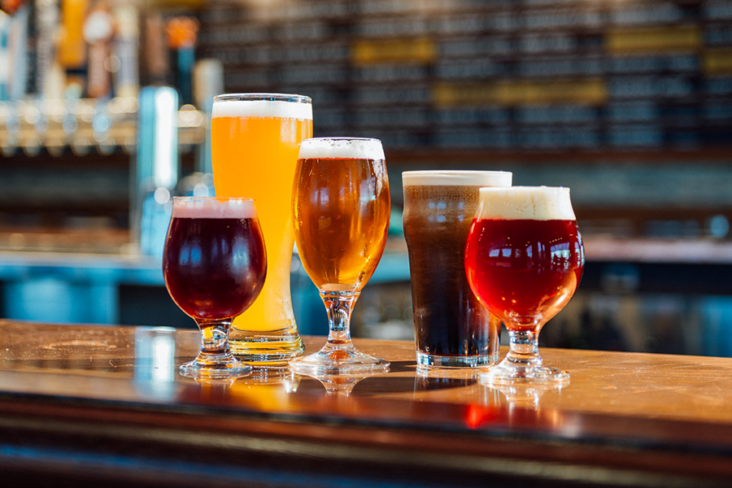‘Aromatic’ rice on the rise as demand for non-alcoholic beer grows
by May 9, 2023 6:55 am 1,116 views

Demand for non-alcoholic beer is rapidly expanding and it has spurred new research using Arkansas-grown aromatic rice to expand flavor profiles of non-alcoholic beer, a category that has grown beyond “near beer” in recent years.
Scott Lafontaine, assistant professor of flavor chemistry for the University of Arkansas System Division of Agriculture, said aromatic rice varieties like the Division’s latest jasmine-type rice, ARoma 22, could offer unique qualities for non-alcoholic beer. Studying the health benefits of non-alcoholic beer is a part of the planned study evaluating how the qualities of rice affect beer brewing.
“We’re going to look at rice in a number of different novel ways,” Lafontaine said. “We will still look at it as a fermentable starch source with a neutral taste, aroma, and color but we’ll also look at what aromatic rice varieties such as ARoma 22 does with aromatics and flavor.”
Assisting him in the research is chemistry Ph.D. student Bernardo Guimaraes. Lafontaine and Guimaraes work in the food science department for the University of Arkansas’ Dale Bumpers College of Agricultural, Food and Life Sciences and the Division of Agriculture’s Arkansas Agricultural Experiment Station.
Lafontaine has been the author or co-author of many published research papers on studies of hops, non-alcoholic beer production, and sensory testing. He will be among the speakers at the Craft Brewers Conference & BrewExpo America on May 10 in Nashville, for a seminar titled “Novel Strategies to Develop Preferable Non-Alcohol and Low-Alcohol Beer and Alternatives.”

With the inventiveness of American craft breweries, non-alcoholic beer is different than what it used to be even just a few years ago, Lafontaine said. A September 2022 Bloomberg report stated the global non-alcoholic beer market was worth $16 billion in 2021 and is forecast to reach more than $23 billion by 2025.
Large commercial brewers are focused on expanding their offerings of non-alcoholic beer brands. For example, Anheuser-Busch (AB) InBev, which owns several major beer brands, has indicated that they intend to have 20% of their global beer volume be no/low alcohol by 2025, Lafontaine said.
Each year, the company spends about $120 million buying Arkansas rice. It’s processed at mill in Jonesboro. The company is the single largest buyer of rice in the U.S.
Athletic Brewing Company in Connecticut has become a leader in the non-alcoholic craft beer movement, he said. Consumer demand for non-alcohol and low-alcohol beers is at an all-time high, according to the Craft Brewers Conference website.
Trey Malone, assistant professor of agricultural economics and agribusiness, said signs of future market growth in the non-alcoholic beer category could be seen in demographic studies that show younger generations drink less alcohol than prior generations when they were the same age.
“This trend only seems to be accelerating, which is why so many breweries are exploring lower-alcohol or zero-alcohol options,” Malone said.
Alcohol-free, or zero-alcohol, beverages are considered those with 0% alcohol. Non-alcoholic drinks are those with 0.5 percent alcohol or less. Low-alcohol beverages are those with 3% or less alcohol.
Malone said surveys on consumption frequency indicate that about half of Americans over 21 do not consume a single standard alcoholic beverage monthly.
In partnership with Division of Agriculture rice breeders, the U.S. Department of Agriculture, and the VLB Berlin, Lafontaine has already experimented with 20 malted rice varieties. Malting involves keeping a grain at a specific moisture level to allow it to sprout slightly under controlled conditions. During this process a host of biochemical changes occur that are important for beer production such as the solubilization of starch or the source of sugar for yeast to produce alcohol, the production of starch-degrading enzymes, and the breakdown of proteins that yeast can use as nutrients during fermentation.
“We have some varieties performing as well as a moderate malted barley from a protein, starch quality, and gelatinization temperature perspective. Interestingly, with some of the pigmented rice where the hull is still intact, we’re seeing some beautiful red hues in wort post boil, which is cool from a color perspective,” Lafontaine said.
“Wort” is the liquid that will become beer once it’s fermented. Gelatinization is required to turn the starch to sugar. Due to the high gelatinization temperature of rice, a brewer needs an extra vessel called an adjunct cooker to use rice in this way.
“If we can produce malted rice varieties with similar characteristics to barley malt, craft brewers will be able to use this raw material without having to make a capital investment to their brewery,” Lafontaine said.
Of course, rice can also be used as grain to simply provide sugars with neutral flavor in beer, Lafontaine added.
Lafontaine explained that there are two general production methods to make a non-alcoholic beer and the type of method impacts the flavor outcome of the product. Biological methods can be performed with lower capital investment and one technique gaining popularity is the use of special yeasts that do not break down simple sugars into alcohol and carbon dioxide but still produce some desired fermentation flavor. Alcohol can also be physically removed from beer via distillation or membrane filtration. These de-alcoholized procedures that can extract alcohol from beer require expensive specialized equipment and therefore a large capital investment, Lafontaine said.
“One of the things that allow U.S. brewers to continually be at the forefront of the modern brewing industry is that our legal definition of beer is broad when compared to other countries like Germany that have a very specific definition of what beer is,” Lafontaine said. “While I think we need to be careful to preserve the essence of beer, there is no doubt that this flexibility has allowed the U.S. craft brewing industry to change and reinvigorate the global brewing industry over the past decades.”
